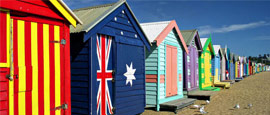Travel to Melbourne
Flying to Melbourne
There are no direct flights to Melbourne from the UK, but some airlines that have routes including stopovers are Thai Airways (via Bangkok), Cathay Pacific (via Hong Kong), Emirates (via Dubai), Singapore Airlines (via Singapore) and Malaysia Airlines (via Kuala Lumpur). Qantas operates direct flights from the USA. Flights are usually most expensive around Christmas, with the cheapest deals available between mid-April and mid-June.
Website:www.melbourneairport.com.au
Location:
Melbourne Airport is located 25km (15 miles) northwest of Melbourne.
Money:
Banking and currency facilities are available from the ANZ bank branches in the departures and arrivals areas of Terminal 2. In addition, Travelex bureaux de change kiosks are located in the same terminal. ATMs are positioned throughout the airport.
Luggage:
Left-luggage facilities are available in the arrivals area of Terminal 2. Terminal 1 lost property enquiries (tel: +61 3 8336 4100) are dealt with separately from those in the rest of the airport, which are handled by the Travellers’ services (tel: +61 3 9297 1805).
Travel by road
VicRoads (tel: +61 3 8391 3216; www.vicroads.vic.gov.au) runs Melbourne’s road system. It provides information on road safety and conditions and requirements for driving in Victoria.
The legal driving age in Victoria is 18 years and traffic drives on the left. Speed limits are usually 40 kph (25 mph) in pedestrian areas, 50 kph (31 mph) in urban areas and 100kph (62mph) on country roads and highways. Foreign visitors can drive using a valid national licence for up to three months, as long as it has a photo.
Special road rules exist to accommodate Melbourne’s trams which often share roads. Cars must stop behind a tram when it stops in the lane in front and cars must queue on the left in order to turn right at intersections marked by ‘Safety Zone' signs (known locally as a 'hook turn'). Hook turn intersections are mostly found in the Melbourne CBD and some in South Melbourne.
Melbourne has two main tollways feeding into the central business district - CityLink to the west and EastLink to the east. Both these toll roads are cashless. To use these tollways, you must either open an account (and receive a remote monitoring device, called an eTag, to attach to the car) or buy a pass before you travel on the tollway. The car you drive must also be registered with Vic Roads.
Royal Automobile Club Victoria (RACV) (tel: +61 3 8832 7980, in Australia only; www.racv.com.au).
Melbourne has good road access to other main cities in Australia. The Western Highway (8) goes towards Adelaide (as does the scenic Great Ocean Road tracing the western coastline of Victoria), the Hume Highway (31) and Princes Highway (1) to Sydney, and the Hume Highway (31) and Barton Highway (25) to Canberra.
From Adelaide - 8 hours; Sydney - 9 hours; Canberra - 7 hours.
Greyhound Australia (tel: +61 7 4690 9850; www.greyhound.com.au) operates extensive services throughout Australia, including routes from Melbourne to Brisbane, Sydney, Canberra, Cairns, and Darwin.
Premier Motor Service (tel: +61 2 4423 5233; www.premierms.com.au) operates services linking Melbourne with Sydney, Gold Coast, Brisbane, Mackay, Rockhampton, Townsville and Cairns.
You can catch these bus services from Melbourne's Southern Cross Bus Station on Spencer Street.
Travel by rail
Australian trains are modern and comfortable with sleeper cars for longer journeys.
Southern Cross Railway Station in Spencer Street operates train services around Melbourne, into regional Victoria and across the country to neighbouring states. It is the terminus of the Overland rail service, the NSW Train Link service and is one of five stations forming the City Loop rail network across the CBD. Flinders Street Station, close to Federation Square, is the main terminal for suburban, metropolitan lines.
V/Line (tel: +61 3 9662 2505; www.vline.com.au) is the regional public transport provider and operates Interstate Link services with connecting coach services, as well as an extensive train service throughout Victoria to destinations including Geelong, Ballarat, Bendigo, Kyneton and Seymour.
Daylink services connect Melbourne to Adelaide by train from Melbourne to Bendigo and by bus from Bendigo to Adelaide. The Canberra Link connects Melbourne to Canberra, by train from Melbourne to Albury, then bus from there to Canberra.
Great Southern Railways (tel: 1800 703 357, in Australia only or +61 8 8213 4401; wwww.greatsouthernrail.com.au) operates some of Australia’s luxury train journeys across Australia. ‘The Overland’ train runs a daylight service between Adelaide and Melbourne in both directions twice a week.
NSW TrainLink (tel: +61 2 4907 7501; www.nswtrainlink.info) operates interstate rail and coach services connecting Melbourne with Sydney (and regional centres in New South Wales), Canberra and Brisbane.
From Adelaide - 10 hours 30 minutes; Sydney - 11 hours.
Do you have any Feedback about this page?
© 2025 Columbus Travel Media Ltd. All rights reserved. No part of this site may be reproduced without our written permission, click here for information on Columbus Content Solutions.








 You know where
You know where